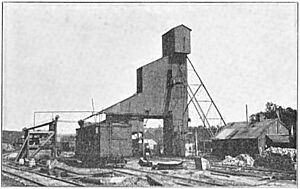Buxton Historic Townsite facts for kids
Quick facts for kids |
|
|
Buxton Historic Townsite
|
|
| Nearest city | Lovilia, Iowa |
|---|---|
| NRHP reference No. | 83000392 |
| Added to NRHP | August 9, 1983 |
The Buxton Historic Townsite is an important historical place located east of Lovilia, Iowa, in Monroe County. It was once a lively community, but it is now an unincorporated area, meaning it no longer has its own local government.
Buxton was started in 1895 by the Chicago and Northwestern Railway. It was a special town built for coal miners. The coal was used to power the railroad's trains. What made Buxton unique was that it was a racially integrated community. This means people of different races lived and worked together. By 1905, most of the people living there were African American, along with many European immigrants.
In the early 1900s, the need for coal changed. Trains started using electricity or diesel instead. This caused coal mining to slow down. A big fire in 1916 also made many people leave. By 1927, everyone had moved away from Buxton. The town site was recognized as a historical place in 1983.
Contents
The Story of Buxton
The story of Buxton began with J.E. Buxton. He came to Iowa in the 1880s to work for the Consolidation Coal Company. This company was part of the Chicago and Northwestern Railway. Their main job was to mine coal to fuel the company's trains.
J.E. Buxton's son, Ben Buxton, took over the company. He needed more workers for the mines. So, the company sent H.A. Armstrong to the Southern United States. He recruited African American workers. They also brought in white workers from other coal mines.
Building a Coal Town
As coal mines in nearby Muchakinock started to close, the railroad built new lines to Monroe County. Ben Buxton, who became the president of Consolidation Coal, founded the town of Buxton in 1895. The railroad bought all the coal mined there. This meant miners had steady jobs and good wages.
Other coal companies, like Ackers Coal Company, also opened mines near Buxton. By the early 1900s, Buxton became the largest coal town west of the Mississippi River. It was also the biggest unincorporated community in the United States.
A Diverse Community
In 1905, Buxton had about 2,700 Black residents and 1,991 white residents. The white residents included immigrants from many countries. These included Belgium, Bohemia, France, Germany, Norway, Russia, Sweden, and Wales. Even with so many different groups, Buxton was known for its lack of segregation. People of different races and backgrounds lived together peacefully.
Buxton was a "company town." This means the Consolidation Coal Company owned most of the town. They built houses, schools, parks, and a YMCA. The company's security guards even acted as the town's police. A large department store, the Monroe Mercantile Company, opened in 1901. It employed 100 people until it burned down in 1911. The town also had its own post office and a famous baseball team called the Buxton Wonders.
Leaders from Buxton
The people of Buxton built a strong community. African Americans living there had many opportunities. They had Black doctors, lawyers, and teachers. Several people from Buxton became well-known across the state and even the country.
- E.A. Carter was the first Black person to graduate from the University of Iowa College of Medicine. He returned to Buxton in 1907. He became the assistant chief surgeon for Consolidation Coal. In 1915, he was promoted to chief surgeon.
- Attorney George H. Woodson helped start the Niagara Movement in 1905. This group later became the National Association for the Advancement of Colored People (NAACP) in 1909.
- Woodson and another Buxton attorney, Samuel Joe Brown, also helped create the National Bar Association in 1925. This was a professional group for Black lawyers.
The Decline of Buxton
Coal production in Buxton reached its highest point in 1914. However, people started leaving the town as early as 1911. By 1915, white residents were the majority. More people left after big fires destroyed parts of the town in 1916. By 1919, only about 400 people remained.
Most of the nearby mines closed in the early 1920s. This was because there was less demand for coal to power trains. In 1923, Consolidation Coal's main office moved to another town. The Buxton post office closed the same year.
The company itself closed in 1925. Buxton mine No. 18, the last mine in the town, closed in 1927. The rest of the town was then emptied. The very last mine in the Buxton area closed in 1932. The Chicago and Northwestern Railway stopped operating in the area in 1935. The train tracks were removed the next year.
After that, most of Buxton's buildings were torn down. Today, much of the land is either covered by forests or used for farming. Only a few ruins remain from the once-thriving town.





